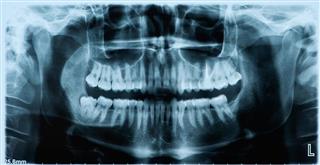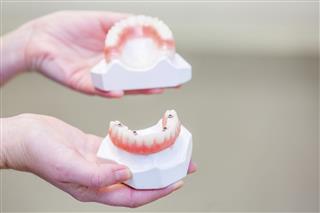
Jaw pain that worsens while having meals is one of the most common symptoms of jaw cancer. Poor oral hygiene and the habit of chewing tobacco is primarily responsible for causing jaw cancer.
Cancer that strikes the tissues of the jaw is referred to as jaw cancer. In this type of cancer, malignant cells form in the jawbone. The cancerous growth, restricts movement of the jaw and sometimes opening the mouth can be a source of great discomfort.
Symptoms
Jaw Pain
Jaw cancer can certainly put a person in an uncomfortable position, as it interferes with normal eating habits. The gradual increase in cancer cells triggers deterioration of jawbone, which results in pain. People suffering from jaw cancer cannot chew the food properly, as it causes pain. Acute pain in the jawbone, while drinking or eating is one of the most common signs of jaw cancer.
Tumor
There is formation of lump on the tissues of the jaw. The lump might be painful and usually forms below the teeth, on the gums. The lumps that have developed on the jawline may also cause tooth pain.
Swollen Jaw
The development of malignant tumor in the jaw, not only causes extreme pain, but leads to swelling of the jaw. The tissues of the jaw appear swollen and can certainly bring great amount of pain.
Moving Teeth
The gums with the cancerous growth are no longer able to hold the teeth tightly. Hence, patients tend to suffer from mobile teeth. So, teeth tend to move around, on being touched.
Localized Facial Swelling
If the tumor is growing on the exterior of the jawbone, localized facial swelling may be noticed. However, in case the cancer growth is occurring inside the jawbone, it may disturb the normal alignment of the jaw.
Numbness or Tingling Sensation in the Jaw
The patient affected with jaw cancer experiences tingling sensation similar to pricking of pins, along the jawline, when the jaw is not moving. This is suggesting that the tumor is putting excessive pressure on the nerves that supply sensation to the oral cavity.
Swollen Lymph Nodes
As lymph nodes are also found below the jawbone (in the neck area), development of lumps under the jawline mean swollen lymph nodes, indicating that the cancer has spread from its original site. When the cancer cells that multiply indiscriminately reach the lymph nodes, one may notice enlargement of lymph nodes. The swelling of lymph nodes usually occurs slowly when the underlying cause is jaw cancer. On the other hand, sudden enlargement of lymph nodes has often been associated with a throat infection. Nevertheless, it is best to consult a doctor and undergo the necessary tests to ‘nail’ the cause of swollen lymph nodes in the neck area.
Causes
Chronic smoking and tobacco chewing are the leading causes of jaw cancer. Over 4000 dangerous chemicals in cigarettes and around 28 known carcinogens in smokeless tobacco can disturb the normal process of cell division and increase the risk of jaw cancer. Alcoholism and untreated dental abscesses may also contribute in the development of jaw cancer.
Types of Jaw Cancer
Cancers of the jaw are often diagnosed as osteosarcomas, malignancy that originates in the bone. Jaw cancer accounts for 8% cases of osteosarcomas. Usually, osteosarcomas affect the arms and legs, especially in the close proximity of the knee joints. Ewing’s Sarcoma is yet another type of primary bone cancer that can occur in the jawbone. Microscopic examination of tissues affected with Ewing’s Sarcoma shows formation of small, round, blue cells. Hence, the cancer is also referred to as blue cell tumor.
Avoid Wrong Judgment
Patients tend to judge jaw cancer pain as a toothache and may use painkillers to resolve the issue. However, this does not work and consultation with the doctor at the earliest, is an absolute must for correct diagnosis.
Treatment
Surgery
Removing the cancerous growth, through surgical procedures can certainly eliminate the tumor once and for all. However, this form of treatment is applicable, only when the tumor is localized and the cancerous cells have not spread beyond a certain limit. The doctor will remove the affected tissues and the lymph nodes near the jawbone, to halt the progress of cancer. The procedure may also involve drilling the affected part of the jawbone in order to get rid of cancerous growth. Surgical procedure is used when the cancer is in its early stages of development.
Radiation Therapy
Bombarding the affected area of the body with high energy rays to destroy the cancerous cells is nothing but radiation therapy. The radiation penetrating through the skin, helps to manage the spread of malignant tumors.
Chemotherapy
Chemotherapy drugs are administered intravenously to kill cancer cells that have invaded tissues of other organs of the body. This treatment method is helpful to relieve the pain associated with cancer.
Upon undergoing surgery and multiple sessions of chemo, one will have to keep meeting the doctor on a regular basis to check for relapse. There is a possibility that the cancer may go into remission and come back at the same site. So. during every visit, the doctor performs blood tests, biopsy and conducts imaging studies to monitor health and look for cancer recurrence.
Disclaimer: The information provided in this article is solely for educating the reader. It is not intended to be a substitute for the advice of a medical expert.





